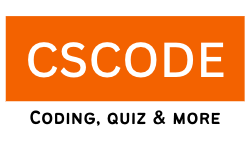Table of Contents
About C Programming language
C is a general-purpose programming language that was developed in the early 1970s by Dennis Ritchie at Bell Labs. It is a high-level language that provides low-level access to system resources, making it popular for system programming, embedded systems, and operating systems.
C is known for its simplicity, efficiency, and portability, and has influenced many other programming languages, such as C++, Java, and Python.
C is used extensively in industries such as automotive, aerospace, telecommunications, and finance. It is also used in the development of computer applications, mobile apps, and video games. C remains a popular choice for programming due to its speed, efficiency, and ability to interface with low-level hardware.
C Interview Questions and Answers
- What is C language?
Answer: C is a general-purpose, high-level programming language that was developed in the 1970s by Dennis Ritchie at Bell Labs. It is widely used for system software, embedded systems, device drivers, and other applications. - What is the difference between an array and a pointer?
Answer: An array is a collection of elements of the same data type stored in contiguous memory locations, whereas a pointer is a variable that stores the memory address of another variable.
In other words, an array is a group of variables of the same data type, while a pointer is a variable that points to the memory location of another variable. - What is a structure in C language?
Answer: A structure is a user-defined data type in C that allows you to group related data items of different data types.
It is similar to a class in object-oriented programming and is used to represent a collection of related data elements. - What is the difference between “++i” and “i++”?
Answer: “++i” and “i++” are both increment operators in C.
The main difference between them is the order in which they increment the value of a variable. “++i” is called the pre-increment operator, and it increments the value of i before using it in an expression. “i++” is called the post-increment operator, and it increments the value of i after using it in an expression. - What is the difference between a local variable and a global variable?
Answer: A local variable is a variable declared inside a function or a block, and its scope is limited to that function or block.
A global variable, on the other hand, is a variable declared outside any function or block, and its scope is global, which means it can be accessed from any part of the program. - What is recursion in C?
Answer: Recursion is a programming technique in which a function calls itself to solve a problem. It is a powerful tool that can simplify complex problems and make them easier to understand and solve. - What is the difference between “scanf” and “gets”?
Answer: “scanf” and “gets” are both used to read input from the user in C.
The main difference between them is that “scanf” is used to read formatted input, while “gets” is used to read a string of characters from the input stream. - What is a pointer in C language?
Answer: A pointer is a variable that stores the memory address of another variable. It allows you to manipulate the value of the variable indirectly by accessing its memory location. - What is the difference between “const” and “volatile” in C?
Answer: “const” and “volatile” are both type qualifiers in C that are used to modify the behavior of variables. “const” is used to declare a variable as read-only, which means its value cannot be changed once it is initialised.
“volatile” is used to declare a variable that may be changed by external events, such as an interrupt or a hardware device. - What is a function pointer in C?
Answer: A function pointer is a variable that stores the memory address of a function. It allows you to call a function indirectly by referencing its memory location. Function pointers are a powerful tool that can be used to implement callbacks, dynamic dispatch, and other advanced programming techniques. - What is the difference between a structure and a union in C?
Answer: A structure is a user-defined data type that allows you to group related data items of different data types, while a union is a user-defined data type that allows you to store different data types in the same memory location.
The main difference between a structure and a union is that a structure allocates memory for each member variable separately, while a union allocates memory for only one member variable at a time, which reduces the memory consumption of the program. - What is a NULL pointer in C?
Answer: A NULL pointer is a pointer that does not point to any valid memory location. It is typically used to indicate that a pointer is not pointing to anything, or to terminate a linked list or other data structure. - What is dynamic memory allocation in C?
Answer: Dynamic memory allocation in C is a technique that allows you to allocate and deallocate memory at runtime. It allows you to create data structures of arbitrary size and complexity, and is used in a wide range of applications, such as image processing, scientific computing, and data analysis. - What is the difference between “malloc” and “calloc” in C?
Answer: “malloc” and “calloc” are both functions used for dynamic memory allocation in C. The main difference between them is that “malloc” allocates a block of memory of a specified size, while “calloc” allocates a block of memory of a specified size and initializes all the bytes to zero. - What is a macro in C?
Answer: A macro in C is a preprocessor directive that allows you to define a symbolic name or a piece of code that can be substituted for a specific text string or expression. Macros are commonly used to define constants, perform inline function calls, and simplify complex expressions. - What is a file pointer in C?
Answer: A file pointer in C is a variable that points to a file stream. It is used to perform input/output operations on files, such as reading from or writing to a file. - What is the difference between “strcmp” and “strncmp” in C?
Answer: “strcmp” and “strncmp” are both string comparison functions in C. The main difference between them is that “strcmp” compares two strings until it reaches the end of either string or a null character, while “strncmp” compares two strings up to a specified length or until it reaches the end of either string or a null character. - What is a bit field in C?
Answer: A bit field in C is a way of packing multiple variables into a single memory location by using a certain number of bits for each variable. It is typically used to conserve memory and improve performance in embedded systems and other applications that have limited resources. - What is the difference between “break” and “continue” in C?
Answer: “break” and “continue” are both control flow statements in C that are used to alter the normal flow of execution in a loop.
“break” is used to terminate the loop and exit the loop body, while “continue” is used to skip the current iteration of the loop and move on to the next iteration. - What is a header file in C?
Answer: A header file in C is a file that contains function prototypes, type definitions, and other declarations that are used in a program. It is typically included in a C program using the “#include” directive and is used to make the code more modular and reusable. - What is a function pointer in C?
Answer: A function pointer in C is a variable that stores the memory address of a function. It allows you to call a function indirectly by using the function pointer instead of the function name. Function pointers are commonly used in callback functions, where a function is called by another function as a parameter. - What is a static variable in C?
Answer: A static variable in C is a variable that retains its value between function calls. It is initialized only once, when the program starts, and is not destroyed when the function that contains it returns. Static variables are commonly used to maintain state information across function calls. - What is a stack in C?
Answer: A stack in C is a data structure that allows you to store and retrieve data in a last-in, first-out (LIFO) order. It is typically used to implement recursive function calls, expression evaluation, and other algorithms that require temporary storage of data. - What is a pointer-to-pointer in C?
Answer: A pointer-to-pointer in C is a pointer that points to another pointer. It allows you to create multiple levels of indirection, which can be useful in certain data structures and algorithms.
Pointer-to-pointer is also known as a double pointer. - What is the “const” keyword in C?
Answer: The “const” keyword in C is used to declare a variable as read-only. Once a variable is declared as “const”, its value cannot be modified during the program execution. “const” is commonly used to declare constants, function parameters, and pointer types. - What is the “typedef” keyword in C?
Answer: The “typedef” keyword in C is used to create a new type alias for an existing data type. It allows you to define complex data structures and function pointers using a simple and easy-to-read syntax. “typedef” is commonly used to define new data types, such as structs, enums, and function pointers. - What is the “volatile” keyword in C?
Answer: The “volatile” keyword in C is used to declare a variable as volatile, which means that its value can be changed by external factors that are beyond the program’s control. This can occur, for example, when the variable is shared between multiple threads or when it is accessed by hardware devices. “volatile” is commonly used to declare global variables that are accessed by multiple functions or interrupts. - What is the difference between “stack” and “heap” in C?
Answer: “Stack” and “heap” are both memory allocation techniques in C. The main difference between them is that the stack is a fixed-size region of memory that is allocated at compile time and is used for function calls and local variables, while the heap is a dynamic region of memory that is allocated at runtime and is used for data structures that require variable-sized memory. - What is a “header guard” in C?
Answer: A “header guard” in C is a preprocessor directive that prevents a header file from being included multiple times in the same program. It is typically used to prevent multiple definitions of the same symbol, which can lead to linker errors and other issues. The most common form of a header guard is “#ifndef/#define/#endif” block. - What is the difference between long and double data types?
Answer: Double is used for storing floating-point values up to a higher precision than float, whereas long is used only for storing large integer value up to a higher precision than int. Both are data types that have a seemingly similar purpose, but are different.
Following is an example of Q.4 What is the difference between “++i” and “i++”?
int i = 1; int a = ++i; // a is assigned the value 2, and i is also incremented to 2. int b = i++; // b is assigned the value 2, but i is incremented to 3 only after the expression is evaluated.




